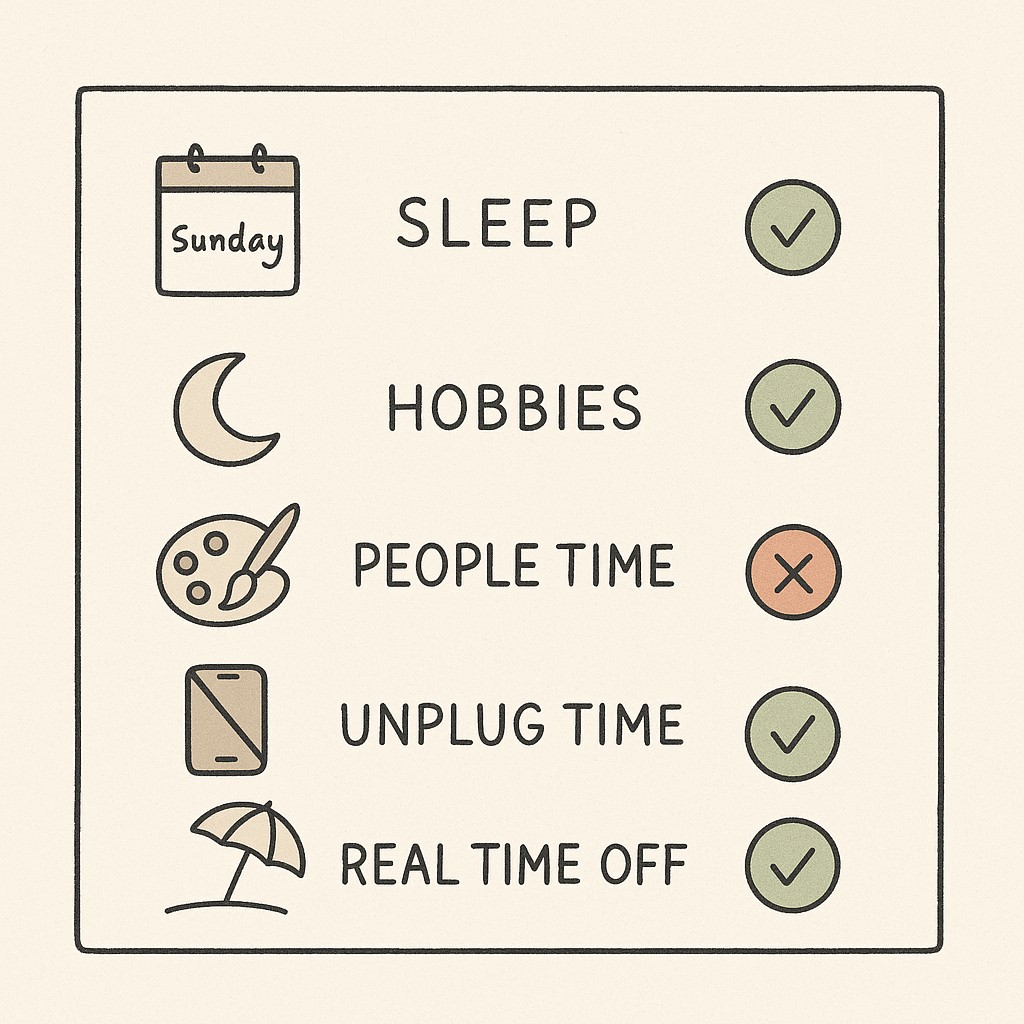Burnout Self Assessment Checklist: The 360 Weekly Check to Catch Slow Erosion Early
Burnout Self Assessment Checklist: The 360 Weekly Check to Catch Slow Erosion Early

The Night “Fine” Turned Into Something Else
It was late on a Saturday, and if I’m honest, the living room had that sort of calm I always chase when the day’s winding down. The screen was full of fresh deploy logs, the last batch still scrolling. Deep work at midnight does something to your head—makes you feel both sharp and slightly untethered. For two hours straight, I felt dialed in. Tiny dopamine hits with each solved problem. But then I checked the clock. It was after midnight.
I tried to remember the last weekend night I’d actually spent on anything except work. Sitting next to my partner. Trading dumb jokes. Sanding a piece of wood for a rough little side project—and wow, I never finished that shelf. All of that felt further off than I’d realized.
I started counting back—one week, two weeks—and it hit me I needed a burnout self assessment checklist. Maybe more. That “just one more push” thing turns out to be contagious, week after week, until you look up and wonder if unplugged time is just some story you tell yourself. At some point, I noticed my forehead felt tight. My eyes didn’t want to focus, and that weird tension crept in. Maybe it’s just a blip. Maybe not.
Why am I still working?
No one had asked me to keep going. I wasn’t behind. I wasn’t being pressured. This was my project. Full autonomy. And honestly—I was building something new, and that felt good. The build itself was fun. But despite having control, the fatigue tasted different that night. Like something deeper was tired. Most nights, I just told myself: “I’m fine.” That night, it didn’t feel fine. Until it suddenly did.
And this, I think, is where so many of us miss the warning signs. Not all burnout is a meltdown. Sometimes it feels like slow erosion—harder to spot, but just as real. That’s why I started checking in with a 360 self-check each week. If you know the feeling—engaged to weary, all in but suddenly dull—you’re not the only one. Noticing when sleep, hobbies, real connection, unplugged time, and true time off start thinning out early is what actually saves you from the slow fade.
How Enjoyment Quietly Crowds Out Recovery
There’s a weird flip side here. The better the work feels, the more you start missing the edge. When you’re deep into code or leading a team through some knotty sprint, it stops feeling like “hours worked” and turns into play. Nobody’s marking your timecard, so the only deadline is inside your head. Honestly, I’m not immune. You barely notice the hours slip away, and if you’re always connected, the feedback loop gets blurry. The overuse is subtle, stretching out until you’re not sure when you last logged off. You lose track, and the signals get softer (link). It’s rarely the big crunch time that gets missed—it’s the gentle drift.
Crisis? You’ll spot that—missed launches, outage nights, the times you’re up until sunrise. Regular little leaks, though? Those sneak past. Late nights can hang together like beads on a string, feeling productive for a while. But then you wake up and realize hobbies are gone, and you can’t remember the last time you had a real conversation. The basics—sleep, movement, actual downtime—erode quietly. Studies link poor sleep to real burnout (correlations up to 0.59, for what that’s worth), but you feel it before you see it (link). The warnings aren’t loud; they seep in.
If you speak engineer, it’s a lot like a memory leak. Everything’s stack-stable for days or weeks, and the system seems fine. But one allocation slips. No alarms at first—until one day you hit a threshold. Lag sets in, things break, and now you’re dealing with a mess. Burnout isn’t all that different. The small bits leak out: sleep, hobbies, connection, unplugged hours, real time off. Miss one, and the next gets shaky. Most of us only feel the hit when two or three are bare—and by then, your resilience is already down.
If you’re “doing fine” but feel off, run a dashboard check to spot early burnout. The key isn’t fixing everything—just catching the drift so it doesn’t snowball.
The 360 Burnout Self Assessment Checklist — Your Weekly Signal Boost
I call it the 360 Burnout Self Assessment Checklist because taking a quick audit once a week actually picks up the quiet drift early. Weekly’s the sweet spot. It’s light, doable, avoids the “too busy” trap. Plus, more than half the week-to-week stress spikes are about what’s happening inside, so this stuff works (link).

What do you track? An early burnout signs checklist covers five basics: sleep, hobbies, people time (and no, Slack doesn’t count), unplugged hours, and true time away. Go simple. Pass/fail, or a 1–3 scale. The goal isn’t hitting all five every week—it’s spotting slips honestly.
Six months ago I was still telling myself landing a streak of “passes” meant I’d figured it out. It’s never that static. Some weeks the sleep is dialed—I’m up early, everything ready—but I haven’t played guitar or seen friends outside work for a month. That’s erosion, even if part of life looks fine. You’re not aiming for perfection, just noticing which basics thinned out. If you white-knuckle your way through, you’ll want to fudge the numbers. Don’t. A missed mark is more telling than a pass. If you’re seeing patterns, grab a recovery playbook before things fall out completely.
The ritual’s quick—ten minutes, same slot each week. I stick to Sunday nights, but any day works if it becomes routine. Bolt on a 60-second check-in: run your list, mark what slipped, choose one tweak, not three. Lowering the bar is more durable. Change could be “phone off by 9pm” or “get lunch with someone outside the org.” Next week? Check again, same five. Head off the overthinking.
Think of this as a burnout checklist for engineers—like setting up an ops dashboard to preempt outages. Set up the alerts—latency, job fails, whatever—early warning is the goal. The burnout check works just the same. Drop in sleep for two weeks? High-latency alert. Unplug time disappears? That’s a flapping container. The tool isn’t for perfect uptime. It’s for catching small deviations so you can course-correct. Admittedly, sometimes I ignore the alerts, thinking “just one more push” will clear next week’s hurdles—still happens, honestly. But when I pay attention, the bounce-back is easier.
That Saturday night? That’s always the callback for me. Why bother with these checks if I could just ride the adrenaline? Because waiting for a “crash” means you spend more time fixing the mess. The goal isn’t less drive—it’s to keep building and enjoying for the long haul. You want your work to light you up, not burn you out. Weekly works. That’s all you need to get started.
Low-Friction Signals and Simple Resets
Start with hobbies. For me, the red flag goes up when my guitar gathers dust (I once used the strings as a makeshift clamp for a soldering project—don’t ask). If I haven’t built, played, or made anything off the clock in a week, it’s never about time—it’s drift. To reboot, steal 60–90 minutes, treat it like a deploy window, and lock time for deep work. Literally put it on your calendar. Ask your team to respect that window, and guard it. Unless the site’s on fire, let it stand. Brain maintenance is real.
Sleep/movement’s next. The technical hack is obvious: track bedtimes, grab whatever movement scratches the itch (I once counted three laps around my kitchen as my “exercise”—not proud, but it made me laugh). If you’re not getting at least five solid nights or your movement feels like manual labor, set a hard cutoff. Laptop closed, no cheating.
Move a standup if you need buffer, and keep your alarm fixed—even if it means less “catch up” after a late night. Miss two out of three on sleep/movement? Your code output’s about to go south. It feels basic, but things always break here first. And yeah, used to think another hour of fixing bugs was worth the next day’s headache. Still find myself negotiating with myself some nights.
Now, time with others. The quiet signal: can you remember a full chat that wasn’t crammed between meetings? If not, set a standing time—coffee, call, whatever. Protect it like uptime. Lose a week, just reboot, no drama.
Next up: time away from notifications to reset work-life boundaries. Inbox is a slow leak. If zero hours unplugged, then it’s red. The reset is simple—schedule DND, flip “away,” automate if you can. Daily windows matter, but Saturday afternoons are magic. Team needs to know when you’re dark. Boundaries reset (link), inbox closed, let brain catch up.
Last, real time off. If your last “day off” meant checking Slack between errands, that’s fake rest. The fix: carve a device-off day, no deploy checks, no inbox. The purpose isn’t “delay work”—it’s recovery, which is way different. Half-rest doesn’t bend the curve, just masks it. So lock it in, defend the time, and try not to second-guess. Real rest sometimes feels risky. I get it.
All these signals and resets are instantly actionable. You’ll notice the drift, pick just one fix, fold it into your flow. No heroics, just low friction. If you’re honest and consistent, that’s what keeps the system humming when the build gets complex.
The Easiest Burnout Defense Is Ten Minutes—Here’s Why It Works
Objection one’s always “I don’t have time.” Thing is, a weekly check-in is faster than sorting a messy Slack thread. Some weeks I’ve clocked hours untangling downtime that ten minutes could’ve dodged. Treat this like updating a package. Run a quick check instead of waiting for the glitch. It really is that simple—a bit of time up front saves you piles later. You wouldn’t skip routine deploys, so don’t skip this. Ten minutes acts as a buffer: early error catch, ongoing stability (Framing cuts down back-and-forth), more output down the line.
Worry you’ll slow down? Counterintuitively, scheduled slowdown boosts speed. You don’t need to quit. Just recalibrate. The best teams run smooth, not emergency-only. Forced downtime is always more costly than optional pauses. So, make the check ritual.
Save time sharing your engineering insights by using our AI to draft blog posts, LinkedIn updates, and X threads fast, then edit in minutes and keep your weekend hours for recovery.
Measuring the invisible is the fuzzy part, so I treat it like a tech burnout self assessment. Honestly, I’m still not perfect here. No fancy dashboards. Just count sleep nights, hobby hours, scan calendar for unplugged time and real conversations. Write a one-liner for the week. “Three decent sleeps, zero guitar, one real offline block.” Lay those facts side by side, let the leaks show. Sometimes I fudge the numbers a bit. It would be cleaner to say I don’t—but the real notes, the days I don’t sugarcoat? Those help me nudge the actual habits, even if I don’t nail every one. I still circle back, sometimes stubbornly, to old patterns. Resolution isn’t automatic.
So, set your day—Sunday night’s my go-to, but pick what sticks. Run the audit, jot the note. If something slips, make one change. Share progress. Tag it up: Burnout Recovery Playbook, hashtag#YourMove, hashtag#BurnoutRecovery, hashtag#SelfCheck, hashtag#MentalHealth, hashtag#WorkLifeBalance. One week at a time, those tweaks build real progress. If nothing else, maybe next Saturday night feels a little lighter. I haven’t nailed the perfect balance—still catch myself sliding instead of recalibrating—but the honest dashboard is how I keep moving.
Enjoyed this post? For more insights on engineering leadership, mindful productivity, and navigating the modern workday, follow me on LinkedIn to stay inspired and join the conversation.
You can also view and comment on the original post here .
